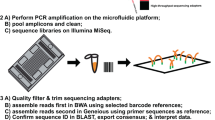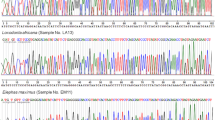Abstract
This protocol describes a method for the extraction of DNA from elephant ivory. These techniques are being used to assign geographic origin to poached ivory by comparing the ivory genotype to a geographic-based gene frequency map, developed separately. The method has three components: ivory pulverization, decalcification and DNA extraction. Pulverization occurs in a freezer mill while the sample is deep frozen in liquid nitrogen, preventing degradation of DNA during the process. Decalcification involves repeated agitation of the sample in 0.5 M ethylenediaminetetraacetic acid over a 4-d period. Extraction follows a modified Qiagen protocol for the extraction of DNA from animal tissue. This method can be used on all forms of ivory. However, DNA recovery is highest when the outermost layer of the tusk, the cementum, is used. When applied to extract DNA from 11 samples, in duplicate, the entire protocol can be completed in 6 d, although much of this time consists of pause points that do not require effort. The protocol provides 0.8 ± 0.11 ng μl−1 (mean ± s.e., n = 48) of DNA per sample.
This is a preview of subscription content, access via your institution
Access options
Subscribe to this journal
Receive 12 print issues and online access
$259.00 per year
only $21.58 per issue
Buy this article
- Purchase on Springer Link
- Instant access to full article PDF
Prices may be subject to local taxes which are calculated during checkout
Similar content being viewed by others
References
Wasser, S.K. et al. Using DNA to track the origin of the largest ivory seizure since the 1989 trade ban. Proc. Natl. Acad. Sci. USA 104, 4228–4233 (2007).
Wasser, S.K. et al. Assigning African elephant DNA to geographic region of origin: applications to the ivory trade. Proc. Natl. Acad. Sci. USA 101, 14847–14852 (2004).
Comstock, K.E., Ostander, E.A. & Wasser, S.K. Amplifying nuclear and mitochondrial DNA from African elephant ivory: a tool for monitoring the ivory trade. Conserv. Biol. 17, 1840–1843 (2003).
Isolation of genomic DNA from compact bone using the DNeasy Tissue Kit. Qiagen User Developed Protocol (DY01.doc Sep-01). http://www1.qiagen.com/literature/protocols/pdf/QA02.pdf.
DNeasy Tissue Handbook (Qiagen Inc., Valencia, CA, 2004).
Wasser, S.K. et al. Scat detection dogs in wildlife research and management: applications to grizzly and black bears in the Yellowhead Ecosystem, Alberta, Canada. Can. J. Zool. 82, 475–492 (2004).
Author information
Authors and Affiliations
Corresponding author
Ethics declarations
Competing interests
The authors declare no competing financial interests.
Rights and permissions
About this article
Cite this article
Mailand, C., Wasser, S. Isolation of DNA from small amounts of elephant ivory. Nat Protoc 2, 2228–2232 (2007). https://doi.org/10.1038/nprot.2007.318
Published:
Issue Date:
DOI: https://doi.org/10.1038/nprot.2007.318
This article is cited by
-
A new multiplex qPCR assay to detect and differentiate big cat species in the illegal wildlife trade
Scientific Reports (2023)
-
Elephant genotypes reveal the size and connectivity of transnational ivory traffickers
Nature Human Behaviour (2022)
-
Molecular sexing of degraded DNA from elephants and mammoths: a genotyping assay relevant both to conservation biology and to paleogenetics
Scientific Reports (2021)
-
Revisiting traditional SSR based methodologies available for elephant genetic studies
Scientific Reports (2021)
-
Distinguishing extant elephants ivory from mammoth ivory using a short sequence of cytochrome b gene
Scientific Reports (2019)
Comments
By submitting a comment you agree to abide by our Terms and Community Guidelines. If you find something abusive or that does not comply with our terms or guidelines please flag it as inappropriate.



